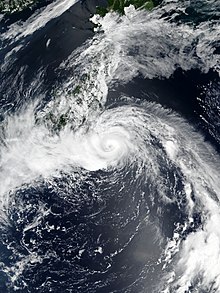Typhoon Jongdari
 Jongdari shortly after peak intensity, while approaching Japan on July 28 | |
| Meteorological history | |
|---|---|
| Formed | July 23, 2018 |
| Dissipated | August 4, 2018 |
| Typhoon | |
| 10-minute sustained (JMA) | |
| Highest winds | 140 km/h (85 mph) |
| Lowest pressure | 960 hPa (mbar); 28.35 inHg |
| Category 2-equivalent tropical cyclone | |
| 1-minute sustained (SSHWS/JTWC) | |
| Highest winds | 165 km/h (105 mph) |
| Lowest pressure | 950 hPa (mbar); 28.05 inHg |
| Overall effects | |
| Fatalities | None |
| Damage | $1.46 billion (2018 USD) |
| Areas affected | Japan, East China |
| IBTrACS | |
Part of the 2018 Pacific typhoon season | |
Typhoon Jongdari was a strong, long-lived and erratic
Jongdari is one of the four Pacific tropical cyclones since 1951 that approached
Meteorological history

Tropical storm (39–73 mph, 63–118 km/h)
Category 1 (74–95 mph, 119–153 km/h)
Category 2 (96–110 mph, 154–177 km/h)
Category 3 (111–129 mph, 178–208 km/h)
Category 4 (130–156 mph, 209–251 km/h)
Category 5 (≥157 mph, ≥252 km/h)
Unknown
A tropical disturbance formed southeast of Guam on July 19 and tracked westward steadily.[2] After issuing a Tropical Cyclone Formation Alert on July 21, the Joint Typhoon Warning Center (JTWC) upgraded the system to a tropical depression early on July 22, although the location of its low-level circulation center was not clear.[3] The Japan Meteorological Agency (JMA), however, kept reporting it as a low-pressure area until it was upgraded to a tropical depression late on July 23.[4] After the slow consolidation for several days, the system was upgraded to a tropical storm near Okinotorishima at around 18:00 on July 24 by agencies such as JMA and JTWC, with an international name Jongdari.[5][6] A microwave imagery revealed a low-level forming eyewall next day, indicating a consolidating system. After JMA upgraded Jongdari to a severe tropical storm at noon,[7] the system accelerated northeastward under the influence of a near-equatorial ridge to the south.[8]
On July 26, as Jongdari started to interact with an upper-level
Jongdari began to be inundated by
Jongdari rapidly weakened after landfall, dissipating on the next day.Impact
Japan
24 people were injured when the typhoon hit Japan.
China
Total damages from Jongdari were about CN¥420 million (US$61.5 million).[22]
See also
- Weather of 2018
- Tropical cyclones in 2018
- Typhoon Damrey (2012)
- Hurricane Sandy (2012) – An Atlantic hurricane in 2012 which executed a similar turn into the Northeastern U.S.
- Typhoon Lionrock (2016)
- Typhoon Noru (2017)
- 2018 Japan heat wave
References
- ^ Araki, Kentaro. "Typhoon No. 12's Unusual Path". Twitter. Retrieved July 29, 2018.
- ^ "bwp152018.dat". Joint Typhoon Warning Center. Retrieved July 27, 2018.
- ^ "Prognostic Reasoning for Tropical Depression 15W (Fifteen) Warning Nr 01". July 22, 2018. Archived from the original on May 23, 2024. Retrieved July 27, 2018.
- ^ "WWJP25 RJTD 231800". Japan Meteorological Agency. July 23, 2018. Archived from the original on May 23, 2024. Retrieved July 27, 2018.
- ^ "RSMC Tropical Cyclone Advisory 241800". Japan Meteorological Agency. July 24, 2017. Archived from the original on May 23, 2024. Retrieved July 27, 2017.
- ^ "Prognostic Reasoning for Tropical Storm 15W (Jongdari) Warning Nr 12". July 24, 2018. Archived from the original on May 23, 2024. Retrieved July 27, 2018.
- ^ "RSMC Tropical Cyclone Advisory 251200". Japan Meteorological Agency. July 25, 2017. Archived from the original on May 23, 2024. Retrieved July 28, 2017.
- ^ "Prognostic Reasoning for Tropical Storm 15W (Jongdari) Warning Nr 15". July 25, 2018. Archived from the original on May 23, 2024. Retrieved July 28, 2018.
- ^ "Prognostic Reasoning for Tropical Storm 15W (Jongdari) Warning Nr 19". July 26, 2018. Archived from the original on May 23, 2024. Retrieved July 28, 2018.
- ^ "RSMC Tropical Cyclone Advisory 261200". Japan Meteorological Agency. July 26, 2017. Archived from the original on May 23, 2024. Retrieved July 28, 2017.
- ^ "RSMC Tropical Cyclone Advisory 270000". Japan Meteorological Agency. July 27, 2017. Archived from the original on May 23, 2024. Retrieved July 28, 2017.
- ^ "Prognostic Reasoning for Typhoon 15W (Jongdari) Warning Nr 23". July 27, 2018. Archived from the original on May 23, 2024. Retrieved July 28, 2018.
- ^ "Prognostic Reasoning for Typhoon 15W (Jongdari) Warning Nr 25". July 28, 2018. Archived from the original on May 23, 2024. Retrieved July 28, 2018.
- ^ "平成30年 台風第12号に関する情報 第73号" (in Japanese). Japan Meteorological Agency. July 28, 2018. Archived from the original on July 28, 2018. Retrieved July 28, 2018.
- ^ "台風第12号 (ジョンダリ) 平成30年07月29日01時50分 発表" (in Japanese). Japan Meteorological Agency. July 28, 2018. Archived from the original on July 28, 2018. Retrieved July 28, 2018.
- ^ "平成30年 台風第12号に関する情報 第94号" (in Japanese). Japan Meteorological Agency. July 29, 2018. Archived from the original on July 29, 2018. Retrieved July 29, 2018.
- ^ "中央气象台03日10时30分发布台风登陆消息" (in Chinese). National Meteorological Center of CMA. August 3, 2018. Archived from the original on August 3, 2018. Retrieved August 3, 2018.
- ^ "Typhoon Jongdari takes an unusual path across Japan". Aljazeera. July 30, 2018. Retrieved July 31, 2018.
- ^ "台風12号:県農林水産被害 総額10億3543万円 /愛知" (in Japanese). Mainichi Shimbun. August 10, 2018. Retrieved October 10, 2018.
- ^ "台風12号の影響による農林水産業への被害について(第3報兼最終報)" (in Japanese). Chiba Local Government. September 10, 2018. Retrieved October 10, 2018.
- ^ News Typhoon Jongdari, July 2018 Typhoon Jongdari (PDF) (Report). Credit Suisse. August 2, 2018. Retrieved October 12, 2018.
- ^ CMA (December 4, 2018). Member Report: China (PDF). ESCAP/WMO Typhoon Committee. ESCAP/WMO Typhoon Committee. pp. 1–2. Archived from the original (PDF) on December 4, 2018. Retrieved December 4, 2018.
External links
- JMA General Information of Typhoon Jongdari (1812) from Digital Typhoon
- 15W.JONGDARI from the U.S. Naval Research Laboratory

